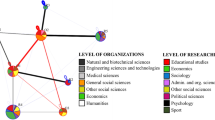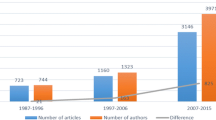Abstract
Multidisciplinary scientific organizations have sought to face the challenges of digital transformation through new governance models that optimize network collaboration and innovation. We studied the collaboration network from the long-term coauthoring system of a Brazilian multidisciplinary organization (Embrapa). The study shows that nodes degree distribution of the network is scale free and degree correlation analysis suggests a disassortative regime from competition and minimal but sufficient control that emerges as a hub-and-spoke pattern. The jobs of controller and researcher are twice as many occupied by males, except for the jobs of analyst, who act like network gatekeeper. With the largest number of individuals in product units, the southern region of the country is more likely to form clusters. Alternatively, hubs in thematic and ecoregional units in the Midwest have greater gravitational attraction, positioning themselves in the inner core of the giant component. The optimization of innovation by the organization should combine greater individual autonomy through improved human capital, with a universal labeling of units as, for instance, centers of innovation.




Similar content being viewed by others
References
Strogatz SH. Exploring complex networks. Nature. 2001;410:268–76. https://doi.org/10.1038/35065725.
Newman MEJ. Mixing patterns in networks. Phys Rev E. 2003;67:026126. https://doi.org/10.1103/PhysRevE.67.026126.
Vosoughi S, Roy D, Aral S. The spread of true and false news online. Science. 2018;359(6380):1146–51. https://doi.org/10.1126/science.aap9559.
Scheufele DA, Krause NM. Science audiences misinformation and fake news. Proc Natl Acad Sci. 2019;116(16):7662–9. https://doi.org/10.1073/pnas.1805871115.
Barabási A-L. Network science. 1st ed. Cambridge: Cambridge University Press; 2016.
Watts DJ, Strogatz SH. Collective dynamics of “small-world” networks. Nature. 1998;393:440–2. https://doi.org/10.1038/30918.
Barabási A-L, Albert R. Emergence of scaling in random networks. Science. 1999;286:509–12. https://doi.org/10.1126/science.286.5439.509.
Barabási A-L, Albert R, Jeong H. Mean-field theory for scale-free random networks. Phys A. 1999;272:173–97. https://doi.org/10.1016/S0378-4371(99)00291-5.
Albert R, Barabási A-L. Statistical mechanics of complex networks. Rev Mod Phys. 2002;74:47–97. https://doi.org/10.1103/RevModPhys.74.47.
Newman MEJ. The structure of scientific collaboration networks. Proc Natl Acad Sci. 2001;98(2):404–9. https://doi.org/10.1073/pnas.98.2.404.
Aiello W, Chung F, Lu L. A random graph model for massive graphs. In: STOC '00 Proceedings of the thirty-second annual ACM symposium on theory of computing. 2000;171–80. https://doi.org/10.1145/335305.335326
Grossman JW, Ion PDF. On a portion of the well-known collaboration graph. Congr Numer. 1995;108:129–31. http://citeseerx.ist.psu.edu/viewdoc/download?doi=10.1.1.35.4242&rep=rep1&type=pdf.
Newman MEJ. Co-authorship networks and patterns of scientific collaboration. Proc Natl Acad Sci. 2004;101(1):5200–5. https://doi.org/10.1073/pnas.0307545100.
Wang Z, Wang N. Knowledge sharing innovation and firm performance. Expert Syst Appl. 2012;39(10):8899–908. https://doi.org/10.1016/j.eswa.2012.02.017.
Caseiro N, Coelho A. The influence of business intelligence capacity network learning and innovativeness on startups performance. J Innov Knowl. 2019;4(3):139–45. https://doi.org/10.1016/j.jik.2018.03.009.
Axtell RL. Zipf distribution of US firm sizes. Science. 2001;293:1818–20. https://doi.org/10.1126/science.1062081.
Gaffeo E, Gallegati M, Palestrini A. On the size distribution of firms: additional evidence from the G7 countries. Phys A. 2003;324(12):117–23. https://doi.org/10.1016/S0378-4371(02)01890-3.
Fix B. Energy hierarchy and the origin of inequality. PLoS ONE. 2019;14(4):e0215692. https://doi.org/10.1371/journal.pone.0215692.
Nacher JC, Akutsu T. Dominating scale-free networks with variable scaling exponent: heterogeneous networks are not difficult to control. New J Phys. 2012;14:073005. https://doi.org/10.1088/1367-2630/14/7/073005.
Takemoto K, Akutsu T. Analysis of the effect of degree correlation on the size of minimum dominating sets in complex networks. PLoS ONE. 2016;11(6):e0157868. https://doi.org/10.1371/journal.pone.0157868.
Rodrigues GS, Campanhola C, Kitamura PC. An environmental impact assessment system for agricultural RD. Environ Impact Assess Rev. 2003;23:219–44. https://doi.org/10.1016/S0195-9255(02)00097-5.
Embrapa. Brazilian Agriculture: one of the most efficient and sustainable in tropical zones. 2017. http://ainfo.cnptia.embrapa.br/digital/bitstream/item/164815/1/38137-folder-sustentabilidade.pdf. Accessed 15 Oct 2020.
Salnikova E, Grunert KG. The role of consumption orientation in consumer food preferences in emerging markets. J Bus Res. 2020;112:147–59. https://doi.org/10.1016/j.jbusres.2020.03.006.
Freitas-Filho A, Paez MLDA, Goedert WJ. Strategic planning in public R&D organizations for agribusiness: Brazil and the United States of America. Technol Forecast Soc Change. 2002;69(8):833–47. https://doi.org/10.1016/S0040-1625(01)00139-1.
Figueiredo PN. New challenges for public research organisations in agricultural innovation in developing economies: evidence from Embrapa in Brazil’s soybean industry. Q Rev Econ Financ. 2016;62:21–32. https://doi.org/10.1016/j.qref.2016.07.011.
Alves AA, Hoffmann A, Nepomuceno AL, Oster AH, Fonseca CEF, Torres CRB et al. Task force to support structural and functional improvement of Embrapa’s Decentralized Units. In: Internal Executive Report. Embrapa Brasília-DF. 2018. p. 28.
Bittencourt DMC, Campos MM, Euclides-Filho K, Moretti C. Análise de redes sociais como ferramenta para a gestão da pesquisa e desenvolvimento (PD) na Embrapa. In: Desafíos y oportunidades de las Ciencias de la Información y la Documentación en la era digital: actas del VII Encuentro Ibérico EDICIC 2015 (Madrid 16–17 November 2015). Universidad Complutense de Madrid, Madrid. https://eprints.ucm.es/34645/1/293-Matias_redes-sociais.pdf.
Mankins J. Technology readiness assessments: a retrospective. Acta Astronaut. 2009;65(9–10):1216–23. https://doi.org/10.1016/j.actaastro.2009.03.058.
Capdeville G, Alves AA, Brasil BSAF. Modelo de Inovação e Negócios da Embrapa Agroenergia: Gestão Estratégica Integrada de P&D e TT. Documentos 24 Embrapa Brasília-DF, 2017. p. 45. https://www.embrapa.br/busca-de-publicacoes/-/publicacao/1085322/modelo-de-inovacao-e-negocios-da-embrapa-agroenergia-gestao-estrategica-integrada-de-pd-e-tt. Accessed 16 Oct 2020.
Embrapa. SEG—Embrapa Management System: manual on the use of the TRL/MRL scale. 2018. https://cloud.cnpgc.embrapa.br/nap/files/2018/08/EscalaTRL-MRL-17Abr2018.pdf. Accessed 16 Oct 2020.
Golbeck J. Analyzing the social web. 1st ed. Amsterdam: Elsevier; 2013.
Marsden PV. Measures of network centrality. Int Encycl Soc Behav Sci. 2015;16:532–9. https://doi.org/10.1016/B978-0-08-097086-8.43115-6.
Newman MEJ, Park J. Why social networks are different from other types of networks. Phys Rev E. 2003;68:036122. https://doi.org/10.1103/PhysRevE.68.036122.
Bastian M, Heymann S, Jacomy M. Gephi: an open source software for exploring and manipulating networks. In: AAI Publications of the third international AAAI conference on weblogs and social media. San Jose CA USA; 2009. https://www.aaai.org/ocs/index.php/ICWSM/09/paper/view/154.
Blondel VD, Guillaume J-L, Lambiotte R, Lefebvre E. Fast unfolding of communities in large networks. J Stat Mech. 2008. https://doi.org/10.1088/1742-5468/2008/10/P10008.
Brandes U. A faster algorithm for betweenness centrality. J Math Soc. 2001;25(2):163–77. https://doi.org/10.1080/0022250X.2001.9990249.
Hu Y. Efficient high-quality force-directed graph drawing. Math J. 2005;10(1):37–71. https://citeseerx.ist.psu.edu/viewdoc/download?doi=10.1.1.353.4547&rep=rep1&type=pdf.
Jacomy M, Venturini T, Heymann S, Bastian M. ForceAtlas2 a continuous graph layout algorithm for handy network visualization designed for the Gephi software. PLoS ONE. 2014;9:e98679. https://doi.org/10.1371/journal.pone.0098679.
Price DS. A general theory of bibliometric and other cumulative advantage processes. J Assoc Inform Sci Technol. 1976;27(5–6):292–306. https://doi.org/10.1002/asi.4630270505.
Zuo Z, Zhao K. The more multidisciplinary the better?—The prevalence and interdisciplinarity of research collaborations in multidisciplinary institutions. J Inform. 2018;12:736–56. https://doi.org/10.1016/j.joi.2018.06.006.
Wise J, Barron AB, Splendiani A, Balali-Mood B, Vansant D, Little E, et al. Implementation and relevance of FAIR data principles in biopharmaceutical RD. Drug Discov Today. 2019;24(4):933–8. https://doi.org/10.1016/j.drudis.2019.01.008.
Sun X, Li H, Ghosal V. Firm-level human capital and innovation: evidence from China. China Econ Rev. 2020;59:101388. https://doi.org/10.1016/j.chieco.2019.101388.
Breton A. Organizational hierarchies and bureaucracies: an integrated essay. Eur J Polit Econ. 1995;11:411–40. https://doi.org/10.1016/0176-2680(95)00011-L.
Callois J-M. Social interaction and economic organization: toward an integrative microeconomic model. Econ Lett. 2013;121(1):98–100. https://doi.org/10.1016/j.econlet.2013.07.013.
Andrés R-P, Min Z. The cost of weak institutions for innovation in China. Technol Forecast Soc Change. 2020;153:119937. https://doi.org/10.1016/j.techfore.2020.119937.
Acknowledgements
The authors thank to Embrapa for providing open data that supported this work. The anonymous dataset explored in this research can be available on request to the corresponding author.
Funding
Nothing to declare.
Author information
Authors and Affiliations
Contributions
Conceptualization: IB; Methodology: IB; Formal analysis and investigation: IB; Writing—original draft preparation: IB; Writing—review and editing: PMS, AHO.
Corresponding author
Ethics declarations
Conflict of interest
The authors are members of the studied organization, whose motivation is to find new organizational models that improve the capacity for scientific innovation based on ethical and transparency principles to cope with a digital world with increasing spread of misinformation and denial.
Additional information
Publisher's Note
Springer Nature remains neutral with regard to jurisdictional claims in published maps and institutional affiliations.
Electronic supplementary material
Below is the link to the electronic supplementary material.
Rights and permissions
About this article
Cite this article
Bergier, I., Santos, P.M. & Oster, A.H. Scientific Collaboration in a Multidisciplinary Organization Revealed by Network Science. SN COMPUT. SCI. 2, 4 (2021). https://doi.org/10.1007/s42979-020-00393-8
Received:
Accepted:
Published:
DOI: https://doi.org/10.1007/s42979-020-00393-8




